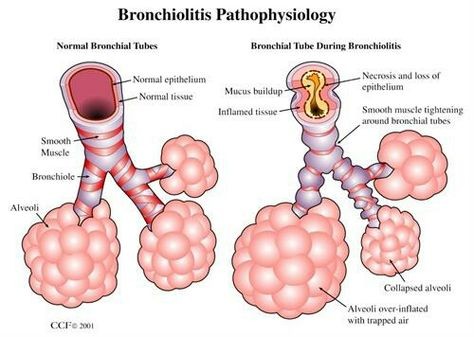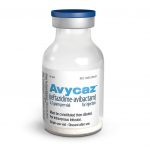
Contents
- 1 Bronchiolitis
- 1.0.1 What is the difference between bronchiolitis and bronchitis?
- 1.0.2 What are the symptoms of bronchiolitis?
- 1.0.3 Is bronchiolitis contagious?
- 1.0.4 What causes bronchiolitis?
- 1.0.5 Are some children more at risk for bronchiolitis?
- 1.0.6 When should I contact my child’s pediatrician?
- 1.0.7 How is bronchiolitis diagnosed?
- 1.0.8 Are there home remedies or therapies for bronchiolitis?
- 1.0.9 What is the medical treatment for bronchiolitis?
- 1.0.10 Is it possible to prevent bronchiolitis?
Bronchiolitis
Bronchiolitis is a viral infection that affects the upper respiratory region (nose, mouth, and throat) and lower respiratory tract (lungs). It primarily affects children under two years of age and is most common during the winter season (November through March in the northern hemisphere).
What is the difference between bronchiolitis and bronchitis?
The terms "bronchiolitis" and "bronchitis" may cause confusion as they are similar, but the difference lies in the specific area of the lungs that is infected.
- Bronchiolitis affects the small and delicate airways called bronchioles that lead to the alveoli.
- Alveoli are microscopic "cul de sacs" in the lungs where the exchange of oxygen and carbon dioxide occurs.
- Bronchitis affects the larger airways called bronchi, which are the first two to three branches of the lungs after the trachea (windpipe).
- Bronchiolitis primarily affects infants and young children, while bronchitis is more commonly seen in teens and adults.
- Both conditions are viral infections and do not require antibiotics.
- Cigarette smoke exposure is a risk factor for both diseases.
What are the symptoms of bronchiolitis?
Bronchiolitis symptoms can be divided into upper respiratory tract symptoms (nose, mouth, and throat) and lower respiratory tract symptoms (lungs).
Upper respiratory tract symptoms of bronchiolitis include:
- Watery nasal drainage
- Nasal congestion
- Possible mild sore throat
- Possible viral infection-induced middle ear pain
- Uncommon fever
After 2 to 3 days, lower respiratory tract symptoms develop, including:
- Cough
- Rapid and shallow breathing
- Increased work of breathing and wheezing
Young children, especially those under 6 months of age, may experience more severe symptoms like:
- Bluish/grey skin discoloration (emergency treatment is required)
- Incessant cough affecting fluid and calorie intake
- Progressive fatigue
- Fever above 101F and worsening of respiratory distress
- Nasal flaring with inspiration
- Respiratory rate greater than 70 inspirations per minute and grunting
- Rarely, episodes of apnea (cessation of breathing) due to exhaustion
Is bronchiolitis contagious?
Bronchiolitis caused by RSV and other viral infections is highly contagious. It can spread through sneezing and coughing, leading to person-to-person transmission. These respiratory viruses can survive for hours on surfaces, increasing the risk of transmission through touching and subsequent contact with the nose or mouth.
What causes bronchiolitis?
Several viruses can cause bronchiolitis. The most common culprit is the respiratory syncytial virus (RSV), which infects most children by the age of two. RSV can cause moderate to severe symptoms, and reinfection is possible throughout childhood and adulthood. Other viral causes include rhinovirus, influenza virus, and various other viruses.
Are some children more at risk for bronchiolitis?
Risk factors for bronchiolitis include:
- Prematurity (
- Age < 12 weeks
- Chronic pulmonary diseases or airway defects
- Certain forms of congenital heart disease
- Immunodeficiency
- Specific neurologic diseases
- Exposure to secondhand smoke
- Crowded living conditions
- Not being breastfed
When should I contact my child’s pediatrician?
You should contact your child’s pediatrician or seek emergency care if your child:
- Has a bluish or grey color on their face, nails, or lips (if severe: call 911 immediately)
- Is breathing very quickly (>70 times per minute)
- Is experiencing respiratory distress, struggling to breathe
- Shows flaring of the nostrils or retractions of the muscles between the ribs or above the breastbone
- Demonstrates progressive fatigue
- Develops a fever >101F
- Is unable to take in fluids or is showing signs of dehydration
How is bronchiolitis diagnosed?
Bronchiolitis is typically diagnosed through a history and physical examination. The child’s blood oxygenation may be assessed using a finger/toe sensor, and a nasal swab may be taken to determine the specific viral cause if hospital admission is necessary. A chest X-ray may be ordered if pneumonia is suspected.
Are there home remedies or therapies for bronchiolitis?
In most cases, home management by parents is sufficient for treating bronchiolitis. This includes maintaining hydration and nutrition in toddlers, ensuring proper pulmonary function, and closely monitoring for worsening symptoms or complications like pneumonia or sleep apnea.
What is the medical treatment for bronchiolitis?
Inhaled bronchodilators were previously a common treatment for bronchiolitis, but recent studies have shown no long-term benefits. However, some centers may provide single inhalation bronchodilator therapy if a child has asthma exacerbations during the bronchiolitis season. Oral bronchodilators, steroids, and chest physiotherapy are not recommended.
If the respiratory rate exceeds 70 per minute, nasal gastric tube utilization or IV fluid administration may be necessary to prevent choking and pulmonary aspiration.
In order for a patient to be discharged from the hospital, they must meet the following criteria:
- Have an appropriate respiratory rate
- Show improvement in respiratory distress and maintain normal oxygenation without supplemental oxygen
- Demonstrate adequate oral intake and hydration
- Parents must be confident in their ability to monitor their infant with provided written guidelines
Antibiotics are not necessary for treating bronchiolitis as it is a viral infection.
Is it possible to prevent bronchiolitis?
- Frequent hand washing can help reduce exposure to bronchiolitis and other respiratory illnesses.
- Breastfeeding and avoiding secondhand smoke are also beneficial prevention measures.
- Palivizumab (Synagis) is a medication that boosts the immune system against RSV. It is injected into the infant’s leg muscle monthly during the RSV season and is primarily used for high-risk children.
- Annual influenza vaccination for infants aged 6 months and older can also reduce the risk of bronchiolitis. Vaccination of caregivers and those in daycare settings is also important.
By clicking Submit, I agree to the MedicineNet’s Terms & Conditions & Privacy Policy and understand that I may opt out of MedicineNet’s subscriptions at any time.
Medically reviewed by Joseph Palermo, DO; Board Certificate: Internal Medicine/Geriatric Medicine
Leiberthal, R. S.L., et al. "Clinical Practice Guideline: The Diagnosis, Management, and Prevention of Bronchiolitis." Pediatrics. November 2014; Vol 134; Issue 5.
Wagner, T. "Bronchiolitis." Pediatrics in Review. October 2009; Vol 30; Issue 10.


